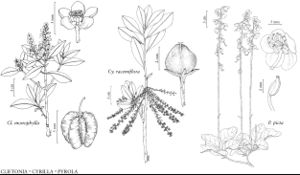Difference between revisions of "Cyrilla"
Syst. Nat. ed. 12, 2: 182. 1767.
Mant. Pl. 1: 5, 50. 1767 ,.
FNA>Volume Importer |
imported>Volume Importer |
||
| Line 49: | Line 49: | ||
|publication year=1767; | |publication year=1767; | ||
|special status= | |special status= | ||
| − | |source xml=https:// | + | |source xml=https://bibilujan@bitbucket.org/aafc-mbb/fna-data-curation.git/src/bb6b7e3a7de7d3b7888a1ad48c7fd8f5c722d8d6/coarse_grained_fna_xml/V8/V8_712.xml |
|genus=Cyrilla | |genus=Cyrilla | ||
}}<!-- | }}<!-- | ||
-->[[Category:Treatment]][[Category:Cyrillaceae]] | -->[[Category:Treatment]][[Category:Cyrillaceae]] | ||
Revision as of 00:14, 28 May 2020
Shrubs or trees, deciduous or semi-evergreen, usually much-branched from base. Leaves: petiole present; blade with prominent midrib and clearly visible lateral veins on both surfaces. Inflorescences clustered at distal ends of branchlets of previous season, produced after shoot growth of current season begins, 6–18 cm; bract persistent. Pedicels: bracteoles persistent, 2. Flowers: sepals lanceolate-ovate, apex acute to acuminate; petals ovate to ovate-lanceolate, base not clawed, apex acute; stamens 5; filaments terete, somewhat expanded basally; ovary 2–3(–4)-locular; ovules 1–3 per locule; stigma 2–3(–4)-lobed. Fruits berrylike, unwinged, ovoid to subglobose. Seeds usually absent, sometimes 1–4.
Distribution
e, sc United States, s Mexico, West Indies, Central America, n South America.
Discussion
Species 1: e, sc United States, s Mexico, West Indies, Central America, n South America.
Several species or varieties of Cyrilla have been distinguished on the basis of local variation in leaf and inflorescence size; most recent floristic treatments follow J. L. Thomas (1960) and recognize a single variable species.
Species 1
